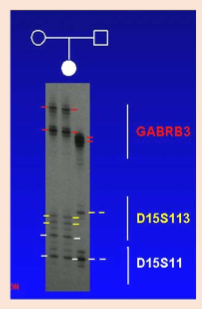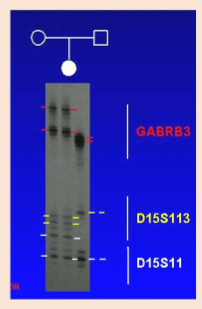Imprinting and Uniparental Disomy (copy)
1/19
Earn XP
Description and Tags
mechanisms and associated disorders
Name | Mastery | Learn | Test | Matching | Spaced |
|---|
No study sessions yet.
20 Terms
Imprinting mechanism
DNA methylation, post-translational histone modification, chromatin structure, noncoding RNAs (RNAi)
Uniparental disomy occurrence
can occur as a random event during the formation of egg or sperm cells or may happen early in fetal development, UPD for some chromosomes have no adverse effect on an individuals but can result in abnormality through aberrant genomic imprinting
UPD definition
two copies or parts of a chromosomes inherited from one parent
heterodisomy: same parental source, 2 chromosome
isodisomy: same parental source, same chromosome
When UPD is associated with phenotypic abnormalities
chromosome or chromosome segment involved carrier genes are imprinted
genes express autosomal recessive condition from a single carrier parent
CFTR gene location
chromosome 7
In prenatal sample
aneuploid cell line with gain/loss of chromosome
not all mosaicisms have potential to become UPD
other UPD cytogenetic warnings
robertsonian translocation, inversion, unusual heteromorphic chromosomal pattern, knowledge of parental translocation/inversion
Mechanism
triaomic rescue
Monosomic rescue
Segmental UPD
Gametic complementation
Trisomic rescue (most common)
Mechanism: early mitotic loss of 1 of trisomy —> become disomic
maternal upd more likely since nondisjunction happens more frequently in oogenesis
2/3 —> loss becomes normal phenotype
1/3 —> loss leads to UPD
UPD type: mixture of heteroisodisomy and isodisomy
Pericentromeric region:
Heterpdosomy → origin from meiosis 1 → Mosaicism present
2 isodisomy → meiosis 2 → present
Monosomic rescue
one chromosome from a normal gamete is duplicated when paired with nullisomic gamete to restore euploidy
Upd type: complete isodisomy
Pericentromeric region: isodisomy
Origin: mitosis
Mosaicism: absent
nondisjunction at meiosis II —> isodisomic
Gametic complementation (post-fertilization error)
fusion of 2 particular gametes, both coincidentally abnormal, one nullisomic other disomic for same chromosome
rare, can expect heterodisomic and isodisomic lines
Mechanism:
Mitotic non-disjunction with dup → upd type complete isodisomy → pericenteomeric region isodisomy → origin mitosis → Mosaicism present
Mitotic recombination of gene conversion → segmental isodisomy → isodisomy or biparental → mitosis → present
segmental UPD
somatic recombination where exchanged region is imprinted
Mechanism: fertilization of disomic and nullisomic gametes
Upd type: mixture of hereroisodisomy and isodisomy
Pericenteomeric region:
Heterodisomy → origin: meiosis 1 → Mosaicism absent
Isodisomy → meiosis 2 → absent
Strategies for detecting UPD
examine more than one recessive disorder
Lacking deletion
Focus on chro with imprinted genes
Examine with apparent balanced trans or chro rearr with ab phenotype
Chromost often involve in germ cell, look for UPD, spontaneous abortuses w/ recessive disorders
UPD in Prader-Willi
Maternal 15q11-13, SNRPN and ZNF127
Maternal UPD is also confirmed by the inheritance of both copies of maternal chro 15 loci in the affected child
Absence of paternal alleles at GABRB3 and D15S113

Prader-Willi molecular analysis
Absence of paternal alleles
maternal UPD also confirmed by inheritance of both copies of maternal 15 in child

UPD in Angelman
paternal 15q11-13, unknown gene
actual mutations detected in UBE3A, SNRPN not methylated and expressed
UPD in Silver-Russell Syndrome
chromosome 7, unknown genesS
low birth rate d/t intrauterine growth retardation, short stature, triangular shaped face, scaphocephaly (long narrow head at birth), normal head size appearing large b/c reduced body length/weight, 5th finger clinodactyly (incurving), poor appetite, developmental delays
UPD in Beckwith-Wiedemann
paternal, 11p15.5 often segmental, candidate imprinted genes are IGF2(pat) and H19(mat)
macroglossia (large tongue), giantism and organomegaly, abdominal wall defects, ear creases, renal abnormalities, predisposition for developing Wilms’ Tumor
Maternal UPD chromosome 14
14p32, include reciprocally imprinted DLK1 and GTL2 genes
low birth weight, developmental delay, precocious puberty, small hands, scoliosis, broad forehead, fleshy nasal tip, otitus media
Summary
UPD results from 2 simultaneous/ subsequent aberrations in cell division leading to the developing zygotehaving 2 copies of himiligousgenetic material from the same parent
Trisomic rescue is the most common
UPD has been observed in nearly every chro number except 12, 18, 19 and Y
The most common UPD chr is 15
UPD does not necessarily lead a an Ab phenotype
A normal phenotype result from UOD of imprinted genes
Imprinted genes have diff expression/methylation patterns on maternal vs paternal homologous generic segments